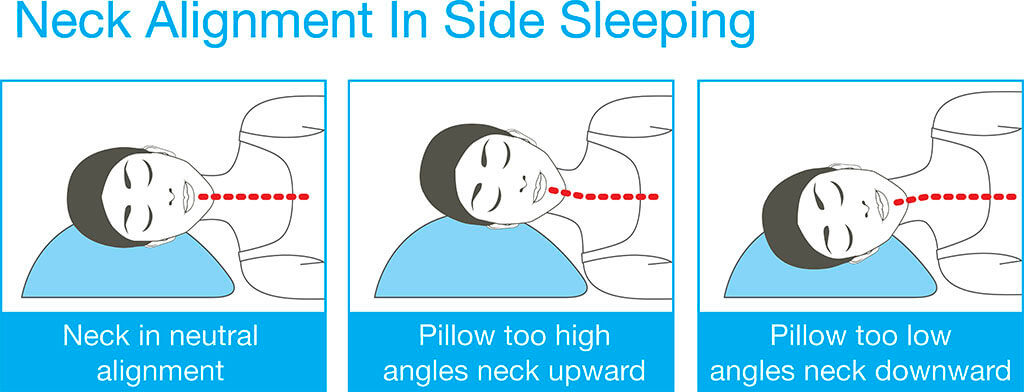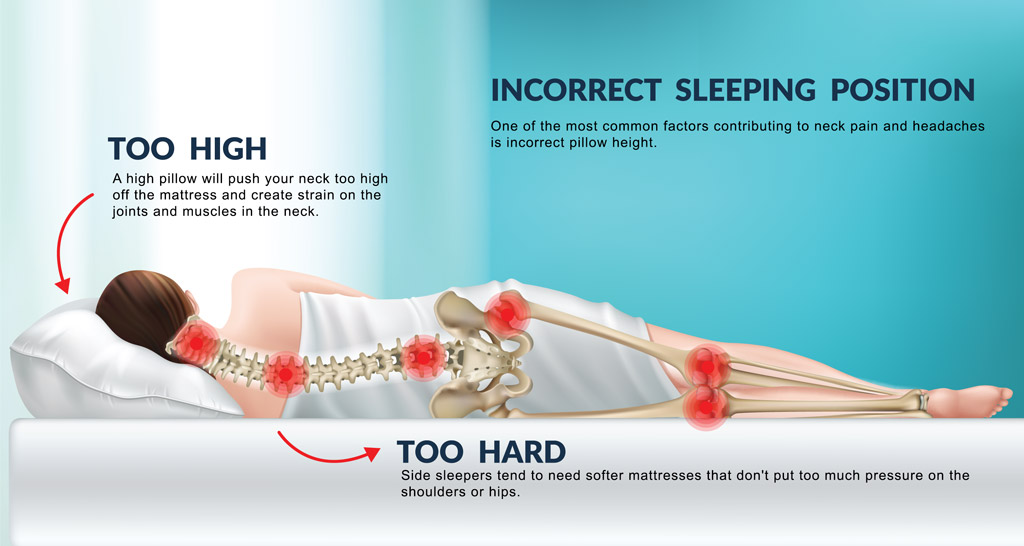
Choosing the right pillow can make a lot of difference in reducing tossing and turning at night, easing body aches and pains and giving you a good night sleep. Sleeping on a wrong pillow can leave you with neck and back pain for weeks. The type of pillow that you need will generally depend on your sleeping position.
Ensuring you’re using the correct pillow is often one of the most important pieces of advice when managing neck and back pain. Too hard, too soft, too big, too thin. Latex, pillow top, memory foam pillow, feathers and down. For sure, there are many pillow types, and it’s tricky to find your ‘just right’ but hopefully we can help navigate you through the process!
Sleeping Position
The position you tend to sleep in the most will determine the height of your orthopaedic pillow. Actually, one of the most common factors contributing to neck pain and headaches is incorrect pillow height. Based on the body’s measurements and personal preference, the perfect pillow height should be between 4 to 6 inches, properly supporting the head and neck (and shoulders when lying on back).
Side Sleepers
- How to get the ideal pillow height for side sleepers? Look for a thicker, firmer mid to high pillow to help support the neck and proper spine alignment. A low pillow will let your head fall too far towards the mattress, not providing enough support for the neck.
- If the pillow is too high, it will push your neck too high off the mattress and create strain on the joints and muscles in the neck.
- Your correct pillow height will depend on how broad your shoulders are. Of course, it can be helpful to have someone check your spinal alignment from behind and even take photos of your sleeping position with different pillows to compare how each one supports your head and neck.
- We recommend: for those with lower back pain, try using a pillow between your knees or beside you at thigh level to stop you from twisting your back through the night.
The way to measure the right pillow height is to lie on your side and to make sure the spine is in perfect alignment. Your pillow must not cause the neck to tilt too much upwards or downwards and should allow for minimal pressure being exerted on the spine, neck and shoulder muscles.

Back Sleepers
- For this sleeping position look for a medium thick pillow. You don’t want it to be too thick, or it will push your head too far forward. You also don’t want it to be too soft, or your head will simply sink down to the mattress.
- We recommend: for those who have back pain, try sleeping with a pillow under your knees – this will take strain off your back while sleeping in this position.
You will just need something that supports the curvature of your neck in order to perfectly align the necks progressive curve. The softness of the mattress will play a slight part in deciding a back sleeping pillow but not as much as for side sleepers.

Back and Side Sleepers
- If you are a back and side sleeper then we recommend finding a pillow that fits for side sleeping but is of a softer density so that when they roll onto their back the pillow will not cause undue pressure to the neck.

Stomach Sleepers
- This is not an ideal sleeping position as it can place excessive stress on your neck and shoulders. If you are unable to break this sleeping habit then no pillow or a flatter pillow is recommended. Your Osteopath will advise you in the strongest terms to try and change this habit. It puts you out of “neutral position” from top to tail. Besides, it does no good and perpetuates the chronic complaint you are most likely presenting with.
- For those who must sleep in this position, chose a thin pillow to avoid excessive strain on the neck.
- If you suffer from chronic neck, shoulder or back pain, your stomach sleeping could be the primary culprit!
Most Common Types Of Pillows
When buying a pillow it is important to first understand the fibres used in the various products. The pillow fillings range greatly in price, materials used and quality.
Latex – Made from a natural compound sourced from rubber trees, latex pillows are natural and organic. They are known for their low allergenic properties and offer excellent support. They are typically firm without causing pressure on the neck and head. Latex pillows hold their shape extremely well but don’t mould easily so be sure to pick one that feels right from the outset. They are one of the most expensive pillows on the market but are also the longest lasting.
Memory Foam – Memory foam reacts to your body heat to become more malleable, allowing it to adapt to the contour of your head and neck. As such, these pillows offer excellent support. However, the do retain heat so can be uncomfortable in warmer seasons.
Synthetic and Polyester – Made from synthesised compounds, these pillows are cheap, light, washable and generally low allergenic. They are some of the cheapest pillows but flatten easily and offer less support and don’t contour well.
Down and Feather – As the name suggests, these are some of the softest pillows. They are light, fluffy and durable but not very supportive. These pillows are best suited to stomach sleepers and won’t provide adequate support for side sleepers.
Try the pillow
It is crucial that you test the pillow out before you buy it. Remember you will be spending about 8 hours every night sleeping on it so it’s worth spending a little time in the store to make sure you get the right one, comfortable and supportive. Also keep in mind that the price isn’t everything and the best pillow for you may not be the most expensive one. It may take about 5 days to get used to your new pillow, so give your body time to adapt.
If you require any further information of pillow choices, please feel free to come in and discuss with our Osteopaths.



